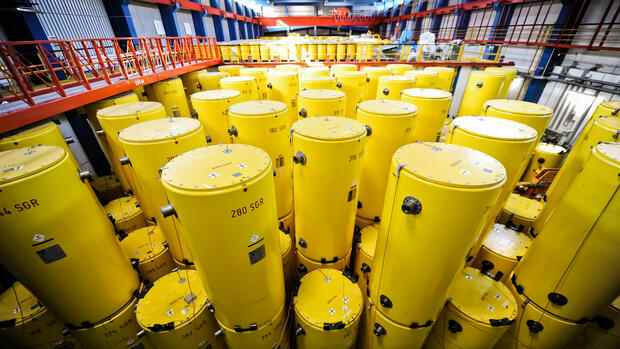Bern According to Swiss experts, the planned location for the Swiss nuclear waste repository near the border to Baden-Württemberg is the safest place for radioactive waste. The Nördlich Lägern region, not far from the German municipality of Hohentengen, is the best choice among the three sites examined for purely geological reasons, said Matthias Braun, head of the National Cooperative for the Disposal of Radioactive Waste (Nagra), on Monday in Bern. “It’s a clear decision. The geology has spoken.”
The necessary rock layer of Opalinus Clay is there deepest under the earth’s surface, the layer is thickest and the possible area for the planned repository is largest. In Nördlich Lägern, traces of the oldest water were found in the rock layer: 175 million years old. That gives him the confidence to make long-term forecasts, Braun said. “The rock is very dense, binds radioactive materials like a magnet, and should it break, it heals itself.”
The packing station for the fuel elements is to be built at the current interim storage facility in Würenlingen, not far from Waldshut-Tiengen in Germany, because there are already buildings there. They just need to be expanded.
The fuel rods, which are around 3.5 to 4.5 meters long and weigh around two kilograms and have a diameter of a good one centimetre, are to be packed there. About one hundred to almost three hundred fuel rods are bundled with spacers to form a fuel assembly.
Top jobs of the day
Find the best jobs now and
be notified by email.
The Federal Office of Energy and the Swiss Federal Nuclear Safety Inspectorate (Ensi) want to examine Nagra’s proposals in the approval process. In addition to four Swiss professors, four German professors are also represented in the Ensi expert group for deep geological repositories.
Decision met with criticism from the Greens
The radioactive waste from nuclear power plants, industry and research is to be buried hundreds of meters deep in the repository. The Federal Office emphasized that the approval had not yet been decided. In the most favorable case, construction could begin in 2031 and storage in 2050.
Switzerland’s decision was met with criticism from the Greens. It is not new that Swiss nuclear waste should be stored near the German border, said the chairman of the Bundestag Committee for the Environment, Nature Conservation, Nuclear Safety and Consumer Protection, Harald Ebner (Greens), the Handelsblatt.
“However, it is surprising that the Nördlich Lägern area, which was classified as rather unsuitable a few years ago, should now be the preferred location,” said Ebner. “For this, a transparent and comprehensible justification is needed, and there must also be an equal participation of the neighboring German communities.”
Ebner emphasized: “Safety must have top priority on both sides of the border, groundwater protection must remain guaranteed.” There must be “close cross-border integration” about the expected loads and effects, which answers open questions.
This also includes the announcement by the Swiss nuclear authority Nagra that the packaging station for the fuel elements will be located at the current interim storage facility in Würenlingen and not at the site of the repository. “Numerous towns and communities on the Upper Rhine are confronted with an increased security risk due to the nuclear transports in the region,” said the Greens politician.
“It’s the geology that matters, not the geography”
The Baden-Württemberg state government reacted cautiously to the Swiss nuclear plans. “We take note of the location proposals and will examine them in exchange with our Swiss neighbors,” a government spokeswoman told the Handelsblatt. “It is initially only an intermediate step in a process that has not yet been completed.”
For example, the Swiss Federal Council and the Federal Assembly would still have to approve the proposals. The spokeswoman added: “As in Germany, the criterion must always be: the geology is decisive, not the geography.”
The German communities reacted with skepticism. They want to check carefully whether Nagra’s justifications are plausible, especially since the Nördlich Lägern site was deferred as a second choice in 2015.
The radioactive waste from nuclear power plants, industry and research is to be buried hundreds of meters deep in the repository.
(Photo: dpa)
According to Braun, uncertainty factors were decisive at the time because the Opalinus Clay layer was so deep there. However, further tests would have proved them wrong: “It turned out that the strength of the rock is about twice as good as it was assessed in the cautious scenario at the time,” he said.
The Swiss answer the question of whether the German radioactive waste could not also be disposed of in the repository so close to the German border with a clear no. “It is a recognized principle that each country must dispose of its own waste at its own facility,” said Roman Mayer, Deputy Director of the Federal Office of Energy.
The surrounding communities should receive compensation payments, confirmed Monika Stauffer, head of the radioactive waste section at the Federal Office of Energy. “The compensation negotiations will be challenging,” she said.
The money should be used for regional development. Who gets how much money has to be negotiated. In a non-binding cost scenario, 800 million francs (822 million euros) were planned for this.
>> Read here: Runtime extension light – Two nuclear power plants remain as an emergency reserve
As a general framework for the repository, Ensi has stipulated that the radiation may not exceed 0.1 millisievert per year, said Felix Altorfer, head of the waste management supervisory area. According to the data available so far, Ensi only expects a maximum of 0.001 millisievert of radiation for the planned camp. In the German Radiation Protection Act, the limit value for the effective dose to protect individuals is set at 1 millisievert per year.
The Swiss nuclear power plant operators estimated the cost of radioactive waste disposal at CHF 18.2 billion last year. You already pay into a fund to cover the costs.
More: Nuclear waste repository on the German border – Swiss plans cause concerns in Berlin
